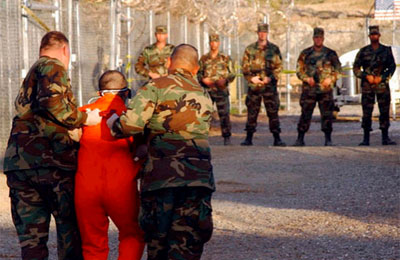
CIA torture... Bahraini government urged to take action.
CIA torture report ‘not surprising’
MANAMA, December 14, 2014
Bahrainis previously imprisoned at Guantanamo Bay say a controversial report exposing CIA torture techniques comes as no surprise having experienced the horror of illegal American interrogation techniques first hand.
Adel Kamal Hajee '“ who was known as inmate 060 at Guantanamo Bay '“ hopes the revelations will spur the Bahraini government to take action on behalf of six citizens formerly imprisoned in Cuba, reported the Gulf Daily News, our sister publication.
A 480-page summary of the Senate Intelligence Committee report details the CIA's campaign against Al Qaeda in the aftermath of 9/11, charting the history of the CIA's 'Rendition, Detention and Interrogation' programme authorised by ex-US president George W Bush after the September 11, 2001 attacks.
It reveals details about how prisoners were treated at so-called 'black sites', facing torture ranging from rectal feeding to being suspended from ceilings by their wrists.
At least one inmate died after prolonged exposure to hypothermia.
'I have not read this report, but what I know is that the US administration is trying to blame some bad people for their actions and come out of all this clean,' Mr Hajee, who now runs a construction business, told the GDN.
'I know what I faced during my time in detention and would like the Bahrain government to file a complaint against the US government for the torture I faced. 'Will they do it?'
Hajee was one of six Bahrainis held at Guantanamo Bay without charge or trial for years.
He was finally released in November 2005 along with fellow Bahrainis Shaikh Salman bin Ebrahim Al Khalifa and Abdulla Majid Al Nuaimi.
Salah Abdulrasool Al Balooshi was released in October 2006, while Juma Al Dossary '“ who attempted suicide 13 times while in American custody '“ was released in 2007.
Isa Abdulla Al Murbati was the last of the Bahrainis to be released on August 8, 2007 after spending six years in an 8x10-foot cell.
Al Dossary now lives in Dammam, while Al Nuaimi was again detained at a Saudi checkpoint on the King Fahad Causeway in October 2008 and, according to rights activists, continues to be held without charge.
The CIA torture report contains damning accounts of prisoner abuse, but Al Murbati '“ now a Management Information Systems student '“ said it couldn't be any worse than the horrific treatment he experienced in Guantanamo Bay's Camp One.
'You would be lucky if the interrogation officer only slapped or punched you in the face compared to the daily torture to break us completely,' said Al Murbati, who was captured fleeing Afghanistan when it was bombed by US and coalition troops in December 2001.
He was accused of being an Al Qaeda fighter with links to the Philippines terror organisation Abu Sayyef.
'I was among a group of detainees who went on hunger strike for months protesting our innocence,' he said.
'These officers force-fed me Ensure (a nutritional supplement) and juices through tubes inserted into my stomach through the nose.'
The 52-year-old said torture was a 'daily practice' used by American interrogation officers to get information.
'They would lock you in a room with the air-conditioning switched off and windows closed and then some cleaning chemical was spilled on the floor,' he recalled.
'The chemical fumes spread across the room and I could not breathe with white liquid coming from my nose and mouth.'
He described how inmates were also exposed to sleep deprivation with loud music being played into their cells to keep them awake.
'Sometimes they took you into a cold dark room and then flashlights were switched on and off at your face with loud music or even a siren playing in the background,' said Al Murbati. 'These officers used to laugh at us while we were in pain.'
He added that forced nudity, cold showers and simulated drowning known as water boarding which is mentioned in the CIA torture report were common at Guantanamo Bay.
'They would place us in stress positions for hours or in shackles on a chair with our hands and legs tied,' he recounted. 'Our bodies were broken in every possible manner inside Guantanamo Bay.'
Dogs were also used by the interrogation officers to intimidate detainees.
'I remember how an inmate was thrown on the ground and a German Shepherd bit him in the leg,' said Al Murbati. 'Some detainees died inside the facility, which the US administration claims were suicides.'
Three such mysterious deaths on the same day in June 2006 involved Saudi detainees Yasser Al Zahrani, Mani Shaman Al Utaybi and Yemeni Salah Al Salami.
The deaths were branded suicides by Guantanamo Bay commander Rear Admiral Harry Harris, who said: 'I believe this was not an act of desperation, but an act of asymmetrical warfare waged against us.'
Mystery
However, Al Murbati '“ whose cell was next door to that of Al Zahrani '“ stated that was not the case.
'I was shouting like many other detainees that day when prison officials suddenly entered his (Mr Al Zahrani's) cell and covered the cell with blankets so that no-one could see what was happening inside,' he said. 'Then I saw his body carried away on a stretcher.'
A case brought against the US and 24 officials, including former Secretary of Defence Donald Rumsfeld, over the deaths of Al Zahrani and Al Salami was thrown out by American courts. – TradeArabia News Service







